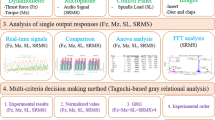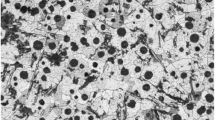Abstract
In this study, the influence of drilling parameters on circularity error, tool tip temperature and flank wear is investigated while drilling of Ti–6Al–4V alloy specimens with dissimilar cutting tool materials under dry machining conditions. In addition, optimal control factors for circularity error, tool tip temperature and flank wear have been determined using Taguchi–Grey relational analysis. Rotational speed of the spindle, feed rate and drill bit material are considered as control factors. Numerous drilling experimental runs have been performed employing L27 orthogonal array on a CNC vertical machining centre with 12Ø-mm-diameter holes on 10-mm-thick plates. An infrared thermal camera FLIR E60 is employed to record the temperature at tool chip interface, and Kistler 8793 tri-axial accelerometer is used to get hold of vibration data in real time. Analysis of variance has been carried out to ascertain the most substantial control factors among rotational speed, feed rate and drill bit material and also to establish the effects of the same over circularity error (Cr), temperature (T) and flank wear (VB).







Similar content being viewed by others

References
Ezugwu EO (2005) Key improvements in the machining of difficult-to-cut aerospace super alloys. Int J Mach Tools Manuf 45(12–13):1353–1367
Mukherjee I, Ray PK (2006) A review of optimization techniques in metal cutting processes. Comput Ind Eng 50(1–2):15–34
Trent EM, Wright PK (2000) Metal cutting. Butterworth-Heinemann, Oxford
Prasanna J, Karunamoorthy L, Raman MV, Prashanth S, Chordia DR (2014) Optimization of process parameters of small hole dry drilling in Ti–6Al–4V using Taguchi and grey relational analysis. Measurement 48:346–354
Giasin K, Ayvar-Soberanis S (2017) An investigation of burrs, chip formation, hole size, circularity and delamination during drilling operation of GLARE using ANOVA. Compos Struct 159:745–760
Kivak T, Habali K, Şeker U (2012) The effect of cutting parameters on the hole quality and tool wear during the drilling of Inconel 718. Gazi Univ J Sci 25(2):533–540
Haq AN, Marimuthu P, Jeyapaul R (2008) Multi response optimization of machining parameters of drilling Al/SiC metal matrix composite using grey relational analysis in the Taguchi method. Int J Adv Manuf Technol 37(3–4):250–255
Shunmugesh K, Kavan P (2017) Investigation and optimization of machining parameters in drilling of carbon fiber reinforced polymer (CFRP) composites. Pigm Resin Technol 46(1):21–30
Prasad BS, Prabha KA, Kumar PG (2017) Condition monitoring of turning process using infrared thermography technique—an experimental approach. Infrared Phys Technol 81:137–147
Sultan AZ, Sharif S, Kurniawan D (2015) Effect of machining parameters on tool wear and hole quality of AISI 316L stainless steel in conventional drilling. Proceedia Manuf 2:202–207
Reddy YRM, Prasad BS (2016) Simulation of form tolerances using CMM data for drilled holes-an experimental approach. J Prod Eng 19(2):77–83
Kushnoore S, Noel D, Kamitkar N, Satish Kumar M (2016) Experimental investigations on thrust, torque and circularity error in drilling of aluminium alloy (Al6061). Am J Mech Ind Eng 1(3):96–102
Wei Y, An Q, Ming W, Chen M (2016) Effect of drilling parameters and tool geometry on drilling performance in drilling carbon fiber–reinforced plastic/titanium alloy stacks. Adv Mech Eng 8(9):168781–4016670281
Gupta V, Pandey PM, Mridha AR, Gupta RK (2017) Effect of various parameters on the temperature distribution in conventional and diamond coated hollow tool bone drilling: a comparative study. Proceedia Eng 184:90–98
Sanjay C, Neema ML, Chin CW (2005) Modeling of tool wear in drilling by statistical analysis and artificial neural network. J Mater Process Technol 170(3):494–500
Yunus M, Alsoufi MS, Munshi SM (2016) Taguchi-Grey relation analysis for assessing the optimal set of control factors of thermal barrier coatings for high-temperature applications. Mech Adv Mater Mod Process 2(1):4
Tosun N (2006) Determination of optimum parameters for multi-performance characteristics in drilling by using grey relational analysis. Int J Adv Manuf Technol 28(5–6):450–455
Markopoulos AP, Habrat W, Galanis NI, Karkalos NE (2016) Modelling and optimization of machining with the use of statistical methods and soft computing. In: Design of experiments in production engineering. Springer, Cham, pp 39–88
Saha A, Mandal N (2013) Optimization of machining parameters of turning operations based on multi performance criteria. Int J Ind Eng Comput 4(1):51–60
Prasad BS, Babu MP (2017) Correlation between vibration amplitude and tool wear in turning: numerical and experimental analysis. Eng Sci Technol Int J 20(1):197–211
Acknowledgements
This work is supported by the Science and Engineering Research Board, Department of Science Technology, Govt. of India under Empowerment and Equity Opportunities for Excellence in Science Scheme with a Grant No: SB/EMEQ-265/2014. Authors would like to thank mentor Sri. P.V.S. Ganesh Kumar, Scientist-H, Associate Director, Naval Science Technological Laboratory Visakhapatnam, India for providing the experimentation test facility and necessary equipment.
Author information
Authors and Affiliations
Corresponding author
Additional information
Technical Editor: Lincoln Cardoso Brandao.
Publisher's Note
Springer Nature remains neutral with regard to jurisdictional claims in published maps and institutional affiliations.
Rights and permissions
About this article
Cite this article
Prasad, B.S., Sai Ravi Kiran, D.S. Experimental investigation to optimize tool performance in high-speed drilling: a comparative study. J Braz. Soc. Mech. Sci. Eng. 41, 535 (2019). https://doi.org/10.1007/s40430-019-2049-4
Received:
Accepted:
Published:
DOI: https://doi.org/10.1007/s40430-019-2049-4



